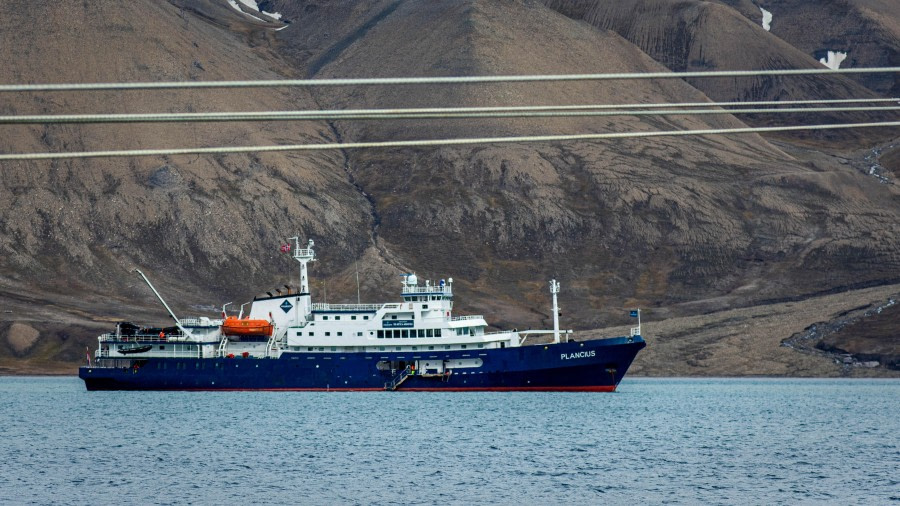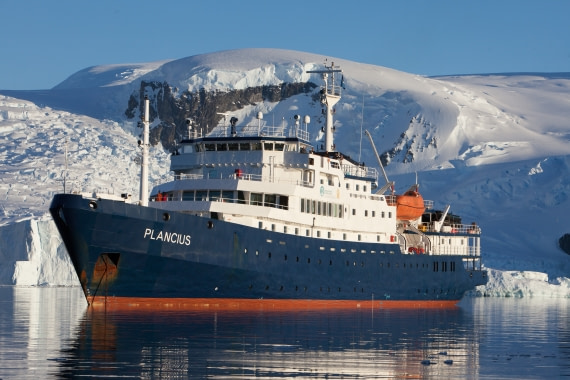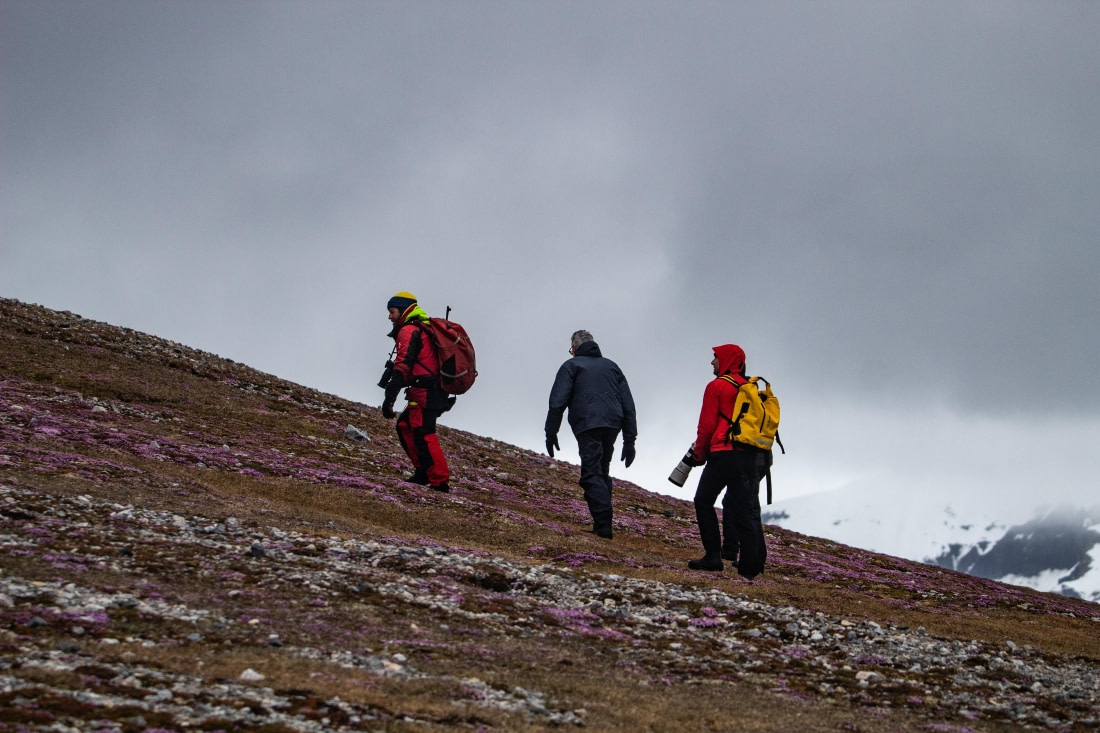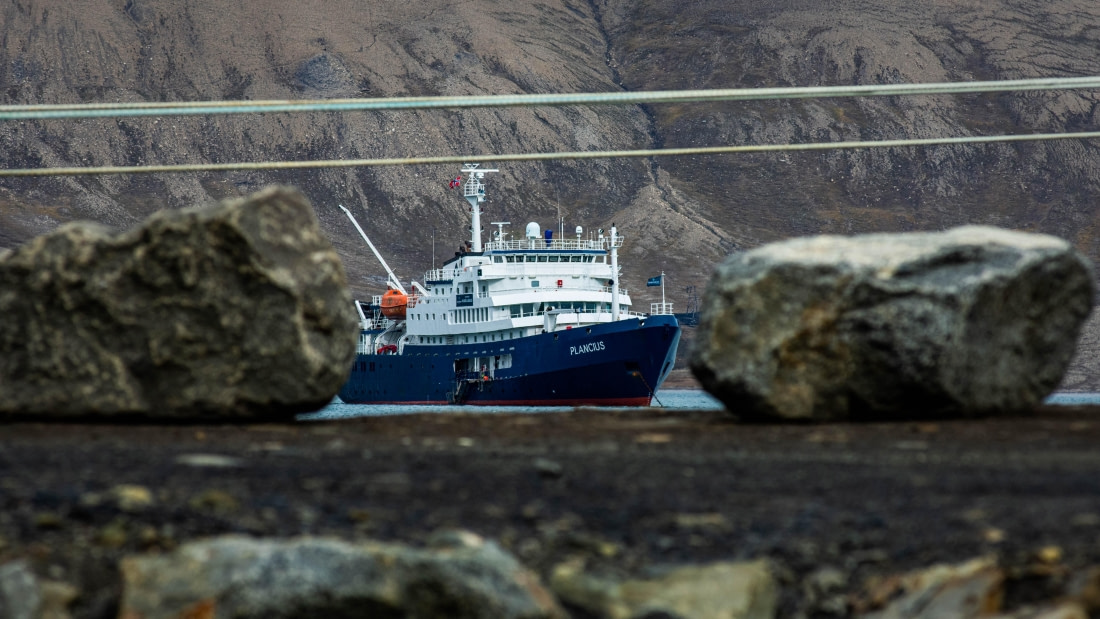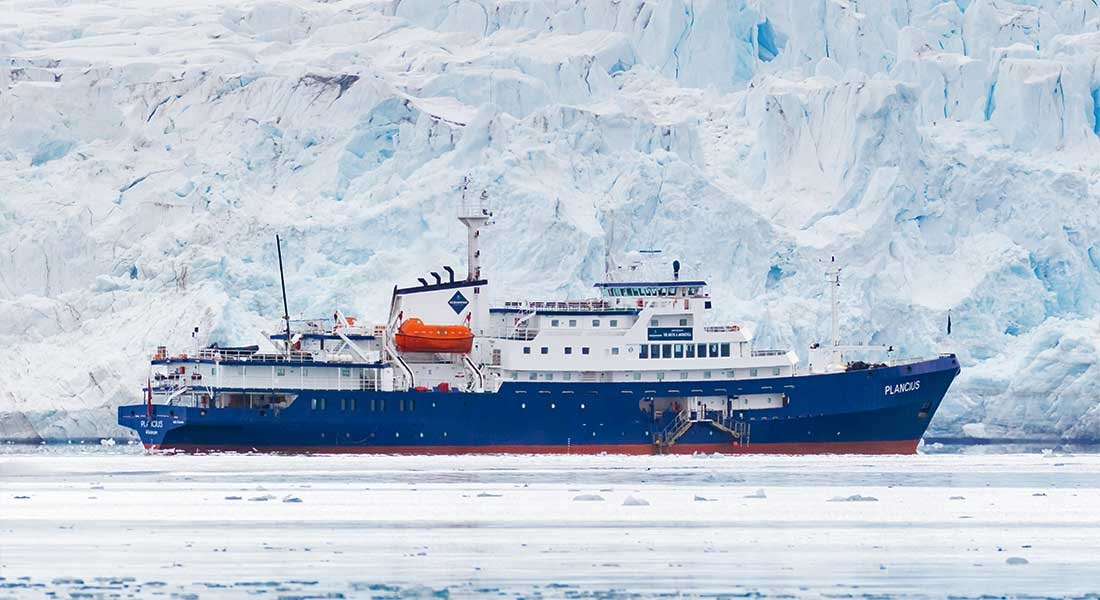| Datum: |
21.06.2024 |
| Position: |
77°00.1'N / 016°09.5'E |
| Wind: |
S2 |
| Wetter: |
Teilweise bewölkt |
| Lufttemperatur: |
+1 |
Nach unserer ersten Nacht auf See in Richtung Süden erreichten wir am frühen Morgen den Eingang zum Hornsund. Der Wind war stark, in Böen bis zu 50 Knoten. Die Berge waren mit Linsenwolken bedeckt, und das Festeis säumte die inneren Bereiche der Fjorde. Wir machten uns auf den Weg in die innerste Bucht des Hornsund, den Brepollen. Dies ist eine Bucht, die von allen Seiten von Gletschern umgeben ist. Diese Gletscher rumpelten einst viel weiter die Täler hinunter als heute und reichten im Jahr 1900 sogar bis nach Treskelen, dem Ort, an dem wir an Land gingen.
Aufgeregte Führer und Gäste wanderten mit ihren Ferngläsern auf den Decks vor Plancius umher. Der lückenhafte Schnee zu dieser Jahreszeit macht die Beobachtung schwierig, so dass man sich konzentrieren muss, wenn man hier etwas finden will. Dunkelgraue Robben wurden auf dem Festeis gesichtet, wo sie neben einem praktischen Loch im Eis ruhten.
Nach dem Frühstück hatten wir unsere obligatorische Einweisung in das Ein- und Ausladen der Zodiacs, eine nützliche Lektion, besonders wenn das Wetter nicht so ruhig ist. Unser Expeditionsleiter Phillipp stellte auch die Pläne für die morgendlichen Wanderungen im Detail vor und erläuterte die Sicherheit der Eisbären.
An der Anlandestelle auf der Westseite von Treskelen machten wir uns in unseren Gruppen auf, die felsige, schneebedeckte Halbinsel zu erkunden. Wir teilten uns in Gruppen auf, damit wir in unserem eigenen Tempo gehen konnten, sei es langsam und gleichmäßig, um viele Fotos zu machen, oder zügig, um auf den Gipfel zu gelangen und die Aussicht nach Osten zu genießen. Von dem hohen Grat aus konnten wir die großen, mit Festeis bedeckten Flächen des Brepollen sehen. Der starke Wind blies uns zurück, als wir versuchten, über den losen Felsen zum Grat hinaufzugehen. Jeder Schritt auf dem Schnee war eine Überraschung, manchmal sank ein Fuß tiefer als das Knie ein, ein anderes Mal hielt das harte Eis den Fuß nahe der Oberfläche.
In unseren Gruppen beobachteten wir die Blumen und Moose, die in dieser rauen Umgebung überleben und sich während des kurzen Sommers zu einem farbenfrohen Schauspiel entwickeln. Am häufigsten sahen wir den Büschelsteinbrech und den Purpursteinbrech, die als Pionierarten die Landschaft besiedeln. Interessant waren auch die Felsen, über die wir spazierten. Es handelt sich um Sedimentschichten, die zu einer Zeit abgelagert wurden, als das Klima und die Umgebung für Spitzbergen noch ganz anders waren. Wir begannen unsere Wanderung auf kalkhaltigem Gestein, das aus einer Zeit stammt, als Svalbard noch weiter südlich lag, in der Nähe des Äquators. Als wir die Spitze des Bergrückens erreichten, fanden wir uns auf dunkel gefärbten Felsen wieder, die Schiefer genannt werden. Diese stehen für eine Veränderung der Bedingungen, als Svalbard aufgrund der Plattentektonik langsam nach Norden driftete und ein Klima erreichte, in dem sich in kalten, flachen Meeren feine Schlämme ablagerten.
Eine Gruppe unternahm auch einen längeren Spaziergang und nahm ein Lunchpaket mit an Land, um die Küstenlinie zu verlängern. Wir aßen in einer alten Trapperhütte zu Mittag, die gelegentlich von privaten Ausflüglern genutzt wird, die den Hornsund besuchen. Unsere Wanderung endete in der Nähe eines steinigen Strandes, von wo aus wir mit dem Shuttle zurück nach Plancius gebracht wurden.
Diejenigen, die nicht an der langen Wanderung teilgenommen hatten, verbrachten den Nachmittag mit einer Zodiac-Fahrt. Die Burgerbukta ist in zwei Fjorde geteilt, nachdem sich die Gletscher über den felsigen Ausläufer zurückgezogen haben. Wir machten uns auf den Weg in den östlichen Fjord der Burgerbukta, wo der Gletscher Mühlbacherbreen eine kalbende Gletscherfront bildet.
Das Festeis bedeckte einen großen Teil der Bucht und machte einen Bereich für die Zodiacs unpassierbar. Eine Kittiewake wurde von einer Raubmöwe angegriffen, was von einigen mit der Kamera festgehalten wurde. Auch Trottellummen und Eissturmvögel wurden gesichtet. Die beeindruckende Landschaft war vom Wasser aus wunderbar zu sehen, und wir fühlten uns klein in dieser riesigen Umgebung.
Am Abend hielten Phillipp, Beth und Eduardo einige Vorträge über die Pläne für den nächsten Tag, die Geologie, die wir heute gesehen hatten, und die Bedeutung dieses Tages als Sommersonnenwende: ein Tag, der für viele Kulturen auf der ganzen Welt wichtig ist!






